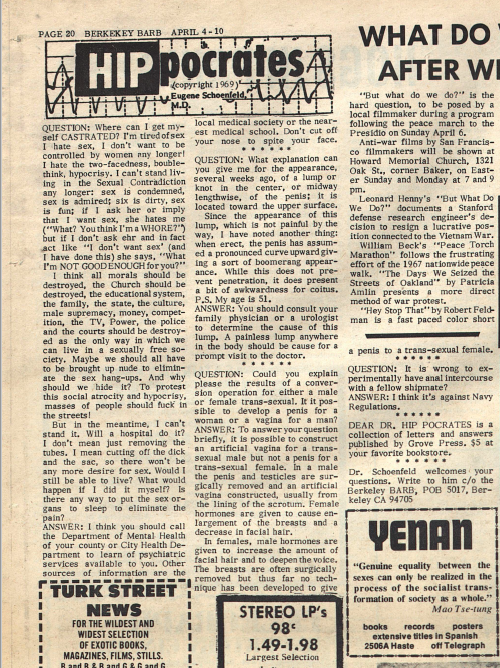The Berkeley Barb offered a medical advice column in which someone named Dr. Schoenfeld answered readers questions. It is significant that in this particular issue from 1969, two people have questions related to trans issues. While the person asking for advice on castration isn’t necessarily trans, there were underground operations during the era that provided at-home bottom surgery for people who wanted it. Underground medical operations were necessary for trans folks because medical services were so inaccessible. What did exist, such as Stanford’s program, was extremely difficult to actually be accepted into. Additionally, the writer’s anxiety regarding their penis and testicles can easily be read as a symptom of gender dysphoria, which often includes extreme states of distress about the physical body. Dr. Schoenfeld points them in the direction of mental health services which makes sense if the doctor isn’t a mental health professional.
The second question about trans issues, which appears just above the advertisements to the right of the first one, again regards the presence of genitalia, keeping in line with the obsession over genital organs in the era. Dr. Schoenfeld’s response displays the amount of medical knowledge regarding hormone therapy and surgery on the eve of the 70s. While he says there is no way to perform phalloplasty, the operation by which a working penis is constructed and put on a body, there is documented evidence of the procedure succeeding well before the 60s. Additionally, the doctor displays his biologically determinant mindset by referring to assigned male at birth people as trans males and assigned female at birth people as trans females when the opposite is true. The person writing in also displays this attitude, asking if a penis could be constructed for a woman or if a vagina could be for a man. Therefore, this article presents an attitude toward trans people both within and outside the community that relies on a biologically determinant mode of thinking with regards to gender. At the time, the common belief held in both cis and trans spaces that gender is not determined by what a person feels, but by what is present on their body. However, the piece does show the presence of trans readership and comfortability the paper had with addressing matters of sexuality.
